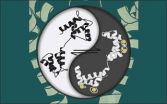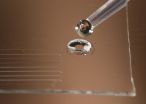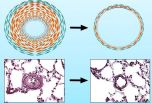(Press-News.org) Influencers trump belief that doctors adopt a new therapy by watching others use it
Surprisingly long road from FDA approval to use by doctors
New technology is like an influential colleague -- opinionated but not too bossy
Doctors need to be reminded every five to seven days
CHICAGO --- Doctors are more likely to try a new therapy when they are persuaded to do so by an influential colleague, reports a new Northwestern University study whose findings on adopting innovations also have relevance for business, education and research.
The authors have used the new finding to simulate a technology intervention that acts like an influential colleague -- opinionated but not too bossy -- that they plan to design for the real world. The goal is to accelerate physicians' adoption of new treatments and tests, which historically can take up to 17 years.
"It's difficult to get doctors to adopt new therapies because you are invading people's comfort zones and the way they usually do things," said lead author Curtis Weiss, M.D., assistant professor of medicine at Northwestern University Feinberg School of Medicine and a physician at Northwestern Memorial Hospital (NMH.)
By analyzing physician social networks, the authors examined how doctors are professionally connected and pass information to each other and how that leads to increasing adoption.
The paper, also by senior author Luis Amaral, professor of chemical and biological engineering at the McCormick School of Engineering and Applied Science and a professor of medicine at Feinberg, was published Oct. 15 in the journal Physical Review X, the journal of the American Physical Society.
The current belief is physicians "catch" a new therapy in what is known as a contagion model. One doctor sees another doctor prescribing a drug or ordering a test, and she will catch or be infected by that new approach and start using it herself.
But the Northwestern study found the art of persuasion was more effective at boosting adoption. The trick was finding the sweet spot in frequency and tone of those persuasive messages so they're effective but not off-putting.
The noodging sweet spot? A reminder every five to seven days delivered as a strong suggestion but not an order, according to the study.
"While our study is focused on critical care physicians, our findings are relevant for other settings in education, research and business where small groups of highly qualified peers make decisions about the adoption of innovations whose utility is difficult if not impossible to gauge," Amaral said.
Long and Winding Road to Convince Doctors to Adopt New Treatments
It's a surprisingly long road from Food and Drug Administration approval of a new drug or technique to doctors actually using the new drug in their practices, noted Weiss, whose research focuses on how to get doctors to adopt best practices.
"The traditional model is a study is published in a journal and discussed at medical conferences, and then doctors in that field were supposed to integrate that into their clinical practice," Weiss said. "The problem with that is doctors are busy and don't always read the journals or go to those conferences. But the bigger issue is even if you read the article and go to the conference, if you don't see a patient with that condition for six months, you may have forgotten the therapy. And there's no follow up or reinforcement after the conference about how to use it."
Analyzing Physician Social Networks for Influencers
The authors analyzed the social networks of critical care physicians in the medical intensive care unit (ICU) at NMH. The test case was a new high-impact serum assay or blood test that measures an enzyme shown to be a marker of life-threatening bacterial infections and sepsis in critically ill patients. The assay has been reported in medical literature as an effective marker but is not yet a part of the guidelines for care. The current way to diagnose infection is a culture but those results take 48 to 72 hours. A quicker diagnosis may improve patient treatment.
Prior to the study, Northwestern didn't have the assay available in its lab. Weiss learned the assay was going to become available and convinced the lab director not to tell anyone before the experiment. Weiss and Amaral then seeded information about the new serum to two other ICU physicians chosen at random. The authors tracked the adoption of the assay over the next nine months, during which time 20 out of 36 doctors adopted the assay.
"We discovered the persuasion model was more accurate in explaining the number and pattern of physicians who started to use the assay," Weiss said.
A computer simulation based on the experimental data aimed at optimizing adoption showed a reminder every five to seven days delivered as a strong suggestion but not an order would have had the greatest impact in accelerating adoption of the new test.
"Optimized interventions could help increase adoption of best practices in hospitals around the country and increase quality of care," Weiss said.
Designing Real-World Interventions to 'Noodge' Doctors
Next the authors plan to design real-world interventions that deliver the knowledge to physicians and emphasize using the new therapy (or best practice) closer to the point at which they would actually use it.
Weiss and Amaral are considering verbal face-to-face reminders, messages sent to pagers or by email, or automated reminders generated by the electronic health record.
Interventions also can regularly audit doctors' adoption. "It could say 'hey, you only used this 30 percent of the time when you should have used it 100 percent of the time,'" Weiss said.
INFORMATION:
Other Northwestern authors on the paper are Julia Poncela-Casasnovas, Joshua I. Glaser, Adam R. Pah, Stephen D. Persell, David W. Baker and Richard G. Wunderink.
NORTHWESTERN NEWS: http://www.northwestern.edu/newscenter/
Persuading doctors to quickly adopt new treatments
Influential colleagues push doctors beyond comfort zone to try new therapies
2014-10-27
ELSE PRESS RELEASES FROM THIS DATE:
Study gives new view on how cells control what comes in and out
2014-10-27
A common protein plays a different role than previously thought in the opening and closing of channels that let ions flow in and out of our cells, researchers at Johns Hopkins report. Those channels are critical to life, as having the right concentrations of sodium and calcium ions in cells enables healthy brain communication, heart contraction and many other processes. The new study reveals that a form of calmodulin long thought to be dormant actually opens these channels wide. The finding is likely to bring new insight into disorders caused by faulty control of these ...
Study finds knowledge poor about stroke in Uganda
2014-10-27
CLEVELAND -- A study published in the journal International Scholarly Research Notices (ISRN) Stroke found that overall knowledge about stroke in Uganda was poor, although knowing what to do for a stroke – go to the hospital – was good.
Researchers from higher education institutions in Uganda collaborated with those from Case Western Reserve University and University Hospitals Case Medical Center to assess residents' knowledge of stroke symptoms and treatment options. To date, public perception and level of knowledge of stroke warning signs and risk factors ...
NASA's Aqua satellite eyeing Tropical Cyclone Nilofar in Arabian Sea
2014-10-27
Tropical Cyclone 04A continues to intensify and had been renamed Tropical Cyclone Nilofar when NASA's Aqua satellite passed overhead on Oct. 27.
The MODIS instrument aboard Aqua captured a visible image of Nilofar that showed a ring of strong thunderstorms around the center of circulation and bands of thunderstorms wrapping into the low-level center from the east and west.
Nilofar attained hurricane strength on Oct. 27, when maximum sustained winds were near 75 knots (86 mph/139 kph) at 1500 UTC (11 a.m. EDT). Nilofar was centered near 15.2 north latitude and 62.2 east ...
When hearing aid users listen to music, less is more, says CU-Boulder study
2014-10-27
The type of sound processing that modern hearings aids provide to make speech more understandable for wearers may also make music enjoyment more difficult, according to a new study by the University of Colorado Boulder.
The findings, published in the journal Ear and Hearing, suggest that less sophisticated hearing aids might actually be more compatible with listening to music, especially recorded music that has itself been processed to change the way it sounds.
"Hearing aids have gotten very advanced at processing sounds to make speech more understandable," said Naomi ...
Delivering a one-two punch: New drug combination shows promise in treating breast cancer
2014-10-27
The uncontrolled growth of cancer cells arises from their ability to hijack the cell's normal growth program and checkpoints. Usually after therapy, a second cancer-signaling pathway will open after the primary one shuts down — creating an ingenious escape route for the cancer cell to survive. The answer, say Case Western Reserve researchers, is to anticipate and block that back-up track by prescribing two drugs from the start. The results of the project, led by Ruth Keri, PhD, Professor and Vice Chair Department of Pharmacology, and Associate Director for Basic Research ...
UH research focuses on suicide resilience and vulnerability
2014-10-27
Religious beliefs and practices may reduce thoughts of suicide among African-American adults in stressful life events induced by racial discrimination, according to a new research study conducted at the University of Houston (UH).
"African-Americans experience an inordinate amount of psychological strain through racial discrimination, leading to depression, hopelessness and other high risk factors for suicide, but demonstrate significantly lower rates of suicide relative to European-Americans," said Rheeda Walker, associate professor and director of the Culture, Risk ...
Synapses always on the starting blocks
2014-10-27
This news release is available in German.
While neurons rapidly propagate information in their interior via electrical signals, they communicate with each other at special contact points known as the synapses. Chemical messenger substances, the neurotransmitters, are stored in vesicles at the synapses. When a synapse becomes active, some of these vesicles fuse with the cell membrane and release their contents. To ensure that valuable time is not lost, synapses always have some readily releasable vesicles on standby. With the help of high-resolution, three-dimensional ...
Satellite movie shows Tropical Storm Ana headed to British Columbia, Canada
2014-10-27
VIDEO:
This animation of NOAA's GOES-West satellite imagery from Oct. 1 -27 shows the movement of Tropical Storm Ana as it heads toward British Columbia, Canada. TRT: 00:20.
Click here for more information.
An animation of imagery from NOAA's GOES-West satellite taken over the period of Oct.19 to 26 shows the movement, intensification, weakening and movement toward British Columbia, Canada. On Oct. 27, wind warnings were posted along some coastal sections of British Columbia.
During ...
Prostate cancer, kidney disease detected in urine samples on the spot
2014-10-27
When you flush the toilet, you may be discarding microscopic warning signs about your health.
But a cunningly simple new device can stop that vital information from "going to waste."
Brigham Young University chemist Adam Woolley and his students made a device that can detect markers of kidney disease and prostate cancer in a few minutes. All you have to do is drop a sample into a tiny tube and see how far it goes.
That's because the tube is lined with DNA sequences that will latch onto disease markers and nothing else. Urine from someone with a clean bill of health ...
Lack of transcription factor FoxO1 triggers pulmonary hypertension
2014-10-27
This news release is available in German.
Pulmonary hypertension is characterised by uncontrolled division of cells in the blood vessel walls. As a result, the vessel walls become increasingly thick.
Scientists at the Max Planck Institute for Heart and Lung Research in Bad Nauheim and Giessen University have discovered that transcription factor FoxO1 regulates the division of cells and plays a key role in the development of pulmonary hypertension. The researchers were able to cure pulmonary hypertension in rats by activating FoxO1. The study findings could ...
LAST 30 PRESS RELEASES:
What causes some people’s gut microbes to produce high alcohol levels?
Global study reveals widespread burning of plastic for heating and cooking
MIT study shows pills that communicate from the stomach could improve medication adherence
Searching for the centromere: diversity in pathways key for cell division
Behind nature’s blueprints
Researchers search for why some people’s gut microbes produce high alcohol levels
Researchers find promising new way to boost the immune response to cancer
Coffee as a staining agent substitute in electron microscopy
Revealing the diversity of olfactory receptors in hagfish and its implications for early vertebrate evolution
Development of an ultrasonic sensor capable of cuffless, non-invasive blood pressure measurement
Longer treatment with medications for opioid use disorder is associated with greater probability of survival
Strategy over morality can help conservation campaigns reduce ivory demand, research shows
Rising temperatures reshape microbial carbon cycling during animal carcass decomposition in water
Achieving ultra-low-power explosive jumps via locust bio-hybrid muscle actuators
Plant-derived phenolic acids revive the power of tetracycline against drug-resistant bacteria
Cooperation: A costly affair in bacterial social behaviour?
Viruses in wastewater: Silent drivers of pollution removal and antibiotic resistance
Sub-iethal water disinfection may accelerate the spread of antibiotic resistance
Three in four new Australian moms struggle with body image
Post-stroke injection protects the brain in preclinical study
Cardiovascular risk score predicts multiple eye diseases
Health: estimated one in ten British adults used or interested in GLP-1 medications for weight loss
Exercise to treat depression yields similar results to therapy
Whooping cough vaccination for pregnant women strengthens babies’ immune system
Dramatic decline in new cases of orphanhood in Uganda driven by HIV treatment and prevention programs
Stopping weight loss drugs linked to weight regain and reversal of heart health markers
Higher intake of food preservatives linked to increased cancer risk
Mass General Brigham–developed cholera vaccine completes phase 1 trial
First experimental validation of a “150-year-old chemical common sense” direct visualization of the molecular structural changes in the ultrafast anthracene [4+4] photocycloaddition reaction
Lack of support for people on weight loss drugs leaves them vulnerable to nutritional deficiencies, say experts
[Press-News.org] Persuading doctors to quickly adopt new treatmentsInfluential colleagues push doctors beyond comfort zone to try new therapies






